Yes, OK, these are my holiday photos, but you don’t have to look at them if you don’t want to, and there is quite a smattering of history in here …
This walk around Brittany followed paths like this, and country lanes, on what the tourist office map describes as the Circuit de Crucano and the Circuit de Sainte-Barbe, just north-east of Plouharnel. (Not a very accurate map I should warn anyone following in my footsteps, although the paths themselves are very well marked.)
The paths appear to be if not ancient (although the way they link ancient sites is suggestive), certainly historic – in fact given the presence of fountains and chapels they are certainly medieval and early modern pilgrimage routes. They are often lined with dry-stone walls and the presence of ancient apple trees unattached to buildings suggests there was once much more settlement here than there is now. There are also lots of blackberries, and it seems the French aren’t much into picking blackberries as they walk, since you don’t even need to get seriously scratched to pick as much as you can eat.
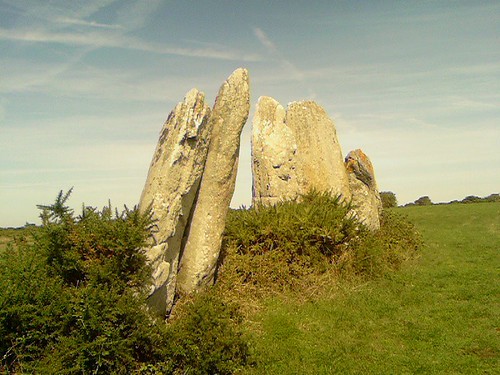
Just north of the Plouharnel Gare SCNF (no trouble crossing the rail line – it only runs July-August, in a very French way!) is the Menhir du Vieux Moulin. (“Standing stones of the old mill” – no longer in evidence). They reminded me of what the guide at the Alignements du Menec said (well she said and a friendly visiting Englishman helped me to understand – her French was tres rapide) about the menhirs at the start of each alignment tending to be placed very close together, forming almost or perhaps in fact a wall – maybe only certain people were allowed to progress beyond that.
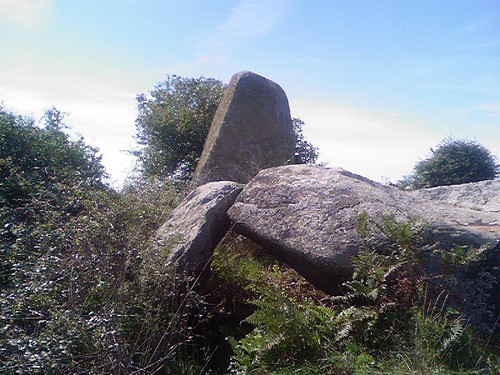
The relationship between the standing stones and the menhirs is obviously complex – and since we are covering a period of about 3,000 years (so from the Greeks to us) it is not surprising if ideas and practices changed quite a lot. But there do often seem to be dolmens near the start of alignments, such as this half-fallen one nearby. The dip in its top forms a handy bird-bath.
There’s then, on the route I took, which combined two routes, both of which are otherwise apparently designed to be started from a car (what is the point of driving a car to go walking??) there was a long, shady run to to Crucuno, where there is a spectacular dolmen (below) tucked against a barn wall. In the 19th century it was much grander – it had a long and complex entry passage – but sadly some farmer decided he needed the land. (A common situation until very recently, I’d imagine; all along the paths you see also what were obviously once standing stones tucked into the construction.)
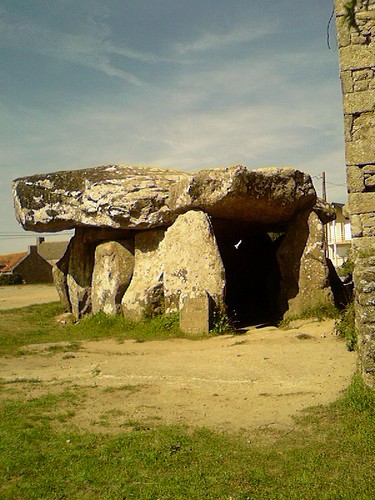

Then it was on to Kergazec, with its still obviously working well. (The village flower garden was put beside it, and I’d expect that’s what the water is used for. Well I’d hope that’s all the water is used for.
The route then winds back through Kernarno, visiting the lovely Chapel of St Anthony, which is marked by this old-looking cross – so weathered I suspect even the experts would find it hard to date.
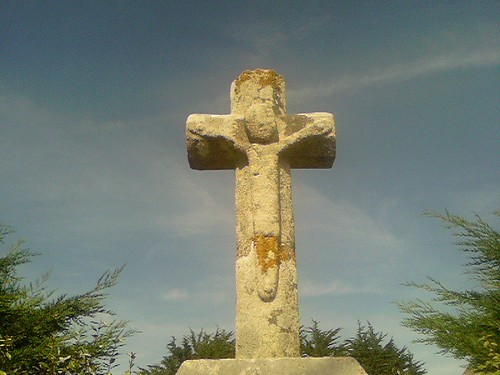
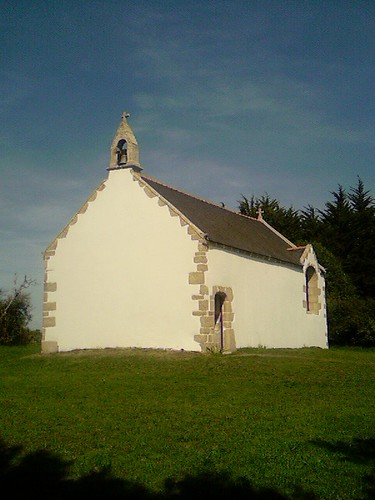
The chapel itself certainly looked old – with its tradiitional Breton stonework – the corner stones are reasonably well shaped and left exposed as a feature, but behind the plaster, from what I saw, is usually a rubble wall.
Just down from the chapel is the matching fountain – a gloriously peaceful spot even if the water had turned a very vivid shade of green. But not, it seems, poisonous green, for the frog population was enormous. I didn’t manage to see any of them – they must be very well camouflaged – but I heard the plop as each concluded I had got too close and decided to flee.
Here I enjoyed a lovely chat with a visiting Frenchwoman from the Grand Massif – very determined to be chatty, but I was really pleased with how my French is coming along … we covered all the usual wherefroms etc, but also discussed the huge variety of butterflies to be seen. I didn’t know their individual names, but then I probably wouldn’t in English either.
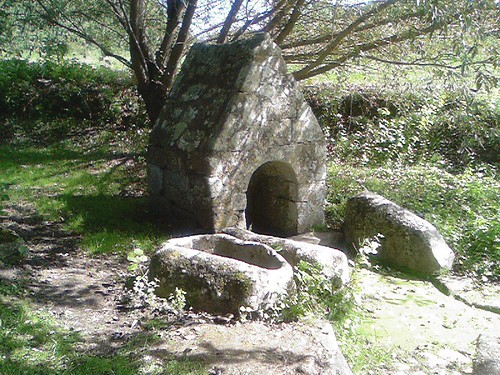
Across the main road (D781) at Kerhellegant, I was distracted by this seductive farm shop. I contemplated a twist of garlic bulbs, but decided that was getting a bit _too_ rustique, so settled for a couple of bottles of farm-bottled cider – one “brut” and one “fils” – a particular apple variety. The French do do this stuff so well…

Through an enormous mobile home park, I came across the alignment of Saint Barbara, which begins with another “closed” strip, but then spread (although much denuded) across the fields for what must be at least a kilometre. You can see hear how often one side of the menhir is curved and the other is relatively straight. The Menec speaker explained that the alignments usually (always?) began at a rise in the land where there was granite outcrop. The first stone would be taken off the top of that – naturally smoothed and rounded by the weather on the top side.
The very strong tendency to start with big stones and get small and smaller as you went away was explained by a simple piece of mechanics – they were the hardest to move so they were put up close to the “quarry”, while smaller pieces were carried further away.
The fascinating question is whether these were seen and established as monuments, or if what mattered was the actual raising of the stone as a ceremony. I gathered there are different theories about this. I asked the Menec speaker (well tried to) if there was evidence of the stone “fields” being kept clear of trees and large plants such as the gorse threatening to swamp it. She said yes, but I’m not entirely sure she understood the question. Anyone know?
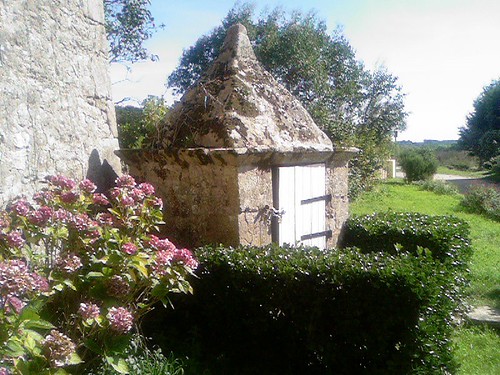
Then it was on to the actual village – v. nice – in fact a bit too artificially nice, perhaps. Lots of the houses seemed to have, attached or nearby, buildings something like this – entrances to grand cellars to store lots of cider, perhaps?
Its claim to fame dates back to 1795, when an English fleet landed on the bay near here three regiments of royalist troops to take on the Revolution. They didn’t, I gather, last long.
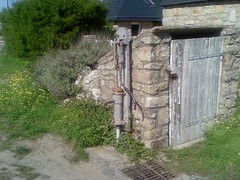 And another looks-like-recently-used-pump – a reminder that these would have been until pretty recently poor places with few facilities like running water in the houses. I’ll share soon some pictures from a lovely book about “women of the sea” of northwest France which talks about the poverty here around a century ago. Then it was because the seasonal run of fish was falling off – and today things are still very dependent on another seasonal crop – tourists.
And another looks-like-recently-used-pump – a reminder that these would have been until pretty recently poor places with few facilities like running water in the houses. I’ll share soon some pictures from a lovely book about “women of the sea” of northwest France which talks about the poverty here around a century ago. Then it was because the seasonal run of fish was falling off – and today things are still very dependent on another seasonal crop – tourists.
 Here I met a friendly local, a very enthusiastic dog. I had to have several goes at getting him to stay with his owners when he set off. (I discovered later why – they were cycling, but in the same direction as I, and I reckon he’d calculated I’d be better, slower, company – and they could catch him up later….)
Here I met a friendly local, a very enthusiastic dog. I had to have several goes at getting him to stay with his owners when he set off. (I discovered later why – they were cycling, but in the same direction as I, and I reckon he’d calculated I’d be better, slower, company – and they could catch him up later….)
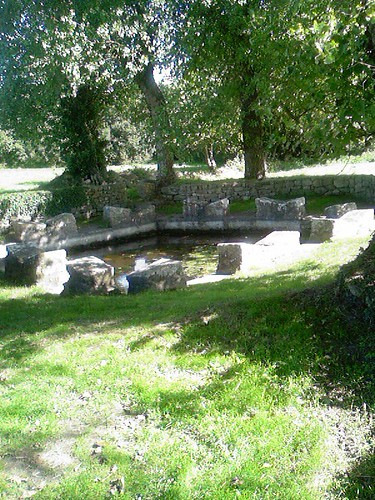
This is one of several lavoirs – village communal laundry facilities along the way. These looked more practical than some – I’d imagine you stacked soapy cloths on one side of the “book” while scrubbing on the other, but I could help wondering why they hadn’t been built higher – these were knee-height, but thigh-height would have saved a lot of bending.
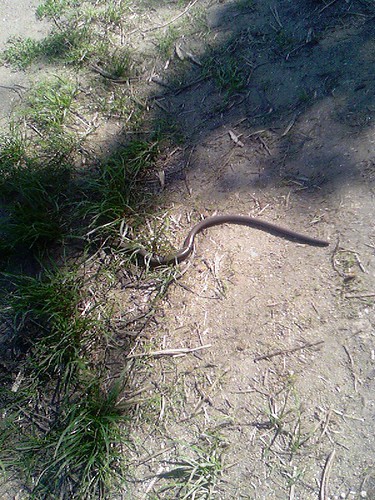 About here was the excitement of the day. A snake!! This was where my French deserted me under pressure. A guy was jogging quite fast down the path towards me when I saw it, and I didn’t know the French for snake, so was reduced to gobbling idiotically and holding up my hand to “stop”. He thought I was frightened of the vipère (as I now know the word); I was just trying to stop him stepping on it. (Actually later research suggested it might have been a slow worm – it was certainly not very quick-moving.)
About here was the excitement of the day. A snake!! This was where my French deserted me under pressure. A guy was jogging quite fast down the path towards me when I saw it, and I didn’t know the French for snake, so was reduced to gobbling idiotically and holding up my hand to “stop”. He thought I was frightened of the vipère (as I now know the word); I was just trying to stop him stepping on it. (Actually later research suggested it might have been a slow worm – it was certainly not very quick-moving.)
Distance c. 10km – very pleasant!
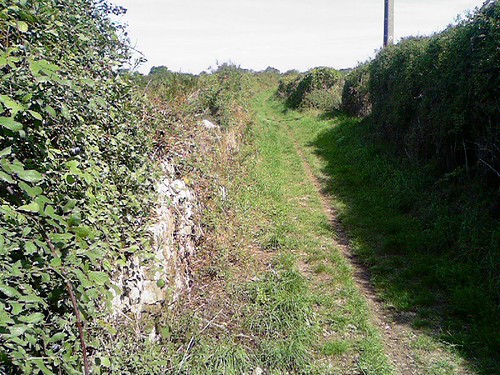
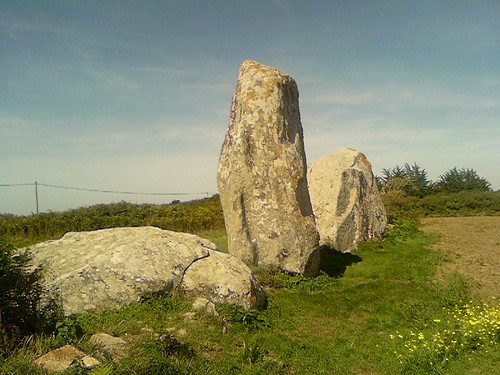

 About
About
3 Comments
Pingback: Tim Worstall